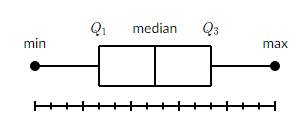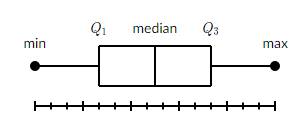
Concept explainers
(a)
To identify the shape of each distribution.
(a)
Answer to Problem 21E
Both the brands are skewed right.
Explanation of Solution
Given information: Box-and-whisker plot.
Calculation:
Both the brands are skewed right.
Fewer data plots are found to the right of the graph. The "tail" of the graph is pulled toward higher positive numbers, or to the right. The mean typically gets pulled toward the tail, and is greater than the median.
(b)
To find the range of upper
(b)
Answer to Problem 21E
Range of upper
Range of upper
Explanation of Solution
Given information: Box-and-whisker plot.
Formula Used: Range of the data=
Calculation:

As the range of the data:
- Brand A
Range of upper
So,
Range of upper
Hence,
Range of upper
- Brand B
Range of upper
So,
Range of upper
Hence,
Range of upper
(c)
To find the interquartile range of data.
(c)
Answer to Problem 21E
Interquartile Range of brand A=
Interquartile Range of brand B=
Explanation of Solution
Given information: Box-and-whisker plot.
Formula Used: Interquartile Range of the data=
Calculation:

As the range of the data:
- Brand A
Interquartile Range of brand A=
So,
Interquartile Range of brand A=
Hence,
Interquartile Range of brand A=
- Brand B
Interquartile Range of brand B=
So,
Interquartile Range of brand B=
Hence,
Interquartile Range of brand B=
(d)
To find the greater standard deviation.
(d)
Answer to Problem 21E
Brand A has greater standard deviation
Explanation of Solution
Given information: Box-and-whisker plot.
Formula Used: Standard deviation =
Calculation:
The standard deviation is approximately equal to the
Also,
The standard deviation is approximately equal to
Both estimates work best for normal distribution, i.e. distributions that are not skewed, and the first approximation works best if they are no outliers. They will later determine additional relations between the standard deviation for
Outliers are data points that fall below
- Range A:
Range of brand A=
Now,
Range of brand A=
So,
Standard deviation =
Hence,
Standard deviation of brand A=
- Range B:
Range of brand B =
Now,
Range of brand B =
So,
Standard deviation =
Hence,
Standard deviation of brand B =
(e)
To identify the brand with more battery life.
(e)
Answer to Problem 21E
Brand A
Explanation of Solution
Given information: Box-and-whisker plot.
Calculation:
Range of brand A=
and
Range of brand B =
Hence,
Brand A will be choose because it has greater range than brand B.
Chapter 11 Solutions
Big Ideas Math A Bridge To Success Algebra 1: Student Edition 2015
- Write the equation for the graphed function. 8+ 7 -8 ง A -6-5 + 6 5 4 3 -2 -1 2 1 -1 3 2 3 + -2 -3 -4 -5 16 -7 -8+ f(x) = ST 0 7 8arrow_forwardThe following is the graph of the function f. 48- 44 40 36 32 28 24 20 16 12 8 4 -4 -3 -1 -4 -8 -12 -16 -20 -24 -28 -32 -36 -40 -44 -48+ Estimate the intervals where f is increasing or decreasing. Increasing: Decreasing: Estimate the point at which the graph of ƒ has a local maximum or a local minimum. Local maximum: Local minimum:arrow_forwardFor the following exercise, find the domain and range of the function below using interval notation. 10+ 9 8 7 6 5 4 3 2 1 10 -9 -8 -7 -6 -5 -4 -3 -2 -1 2 34 5 6 7 8 9 10 -1 -2 Domain: Range: -4 -5 -6 -7- 67% 9 -8 -9 -10-arrow_forward
- 1. Given that h(t) = -5t + 3 t². A tangent line H to the function h(t) passes through the point (-7, B). a. Determine the value of ẞ. b. Derive an expression to represent the gradient of the tangent line H that is passing through the point (-7. B). c. Hence, derive the straight-line equation of the tangent line H 2. The function p(q) has factors of (q − 3) (2q + 5) (q) for the interval -3≤ q≤ 4. a. Derive an expression for the function p(q). b. Determine the stationary point(s) of the function p(q) c. Classify the stationary point(s) from part b. above. d. Identify the local maximum of the function p(q). e. Identify the global minimum for the function p(q). 3. Given that m(q) = -3e-24-169 +9 (-39-7)(-In (30-755 a. State all the possible rules that should be used to differentiate the function m(q). Next to the rule that has been stated, write the expression(s) of the function m(q) for which that rule will be applied. b. Determine the derivative of m(q)arrow_forwardSafari File Edit View History Bookmarks Window Help Ο Ω OV O mA 0 mW ర Fri Apr 4 1 222 tv A F9 F10 DII 4 F6 F7 F8 7 29 8 00 W E R T Y U S D பட 9 O G H J K E F11 + 11 F12 O P } [arrow_forwardSo confused. Step by step instructions pleasearrow_forward
- In simplest terms, Sketch the graph of the parabola. Then, determine its equation. opens downward, vertex is (- 4, 7), passes through point (0, - 39)arrow_forwardIn simplest way, For each quadratic relation, find the zeros and the maximum or minimum. a) y = x 2 + 16 x + 39 b) y = 5 x2 - 50 x - 120arrow_forwardIn simplest terms and step by step Write each quadratic relation in standard form, then fi nd the zeros. y = - 4( x + 6)2 + 36arrow_forward
- In simplest terms and step by step For each quadratic relation, find the zeros and the maximum or minimum. 1) y = - 2 x2 - 28 x + 64 2) y = 6 x2 + 36 x - 42arrow_forwardWrite each relation in standard form a)y = 5(x + 10)2 + 7 b)y = 9(x - 8)2 - 4arrow_forwardIn simplest form and step by step Write the quadratic relation in standard form, then fi nd the zeros. y = 3(x - 1)2 - 147arrow_forward
 Algebra and Trigonometry (6th Edition)AlgebraISBN:9780134463216Author:Robert F. BlitzerPublisher:PEARSON
Algebra and Trigonometry (6th Edition)AlgebraISBN:9780134463216Author:Robert F. BlitzerPublisher:PEARSON Contemporary Abstract AlgebraAlgebraISBN:9781305657960Author:Joseph GallianPublisher:Cengage Learning
Contemporary Abstract AlgebraAlgebraISBN:9781305657960Author:Joseph GallianPublisher:Cengage Learning Linear Algebra: A Modern IntroductionAlgebraISBN:9781285463247Author:David PoolePublisher:Cengage Learning
Linear Algebra: A Modern IntroductionAlgebraISBN:9781285463247Author:David PoolePublisher:Cengage Learning Algebra And Trigonometry (11th Edition)AlgebraISBN:9780135163078Author:Michael SullivanPublisher:PEARSON
Algebra And Trigonometry (11th Edition)AlgebraISBN:9780135163078Author:Michael SullivanPublisher:PEARSON Introduction to Linear Algebra, Fifth EditionAlgebraISBN:9780980232776Author:Gilbert StrangPublisher:Wellesley-Cambridge Press
Introduction to Linear Algebra, Fifth EditionAlgebraISBN:9780980232776Author:Gilbert StrangPublisher:Wellesley-Cambridge Press College Algebra (Collegiate Math)AlgebraISBN:9780077836344Author:Julie Miller, Donna GerkenPublisher:McGraw-Hill Education
College Algebra (Collegiate Math)AlgebraISBN:9780077836344Author:Julie Miller, Donna GerkenPublisher:McGraw-Hill Education





